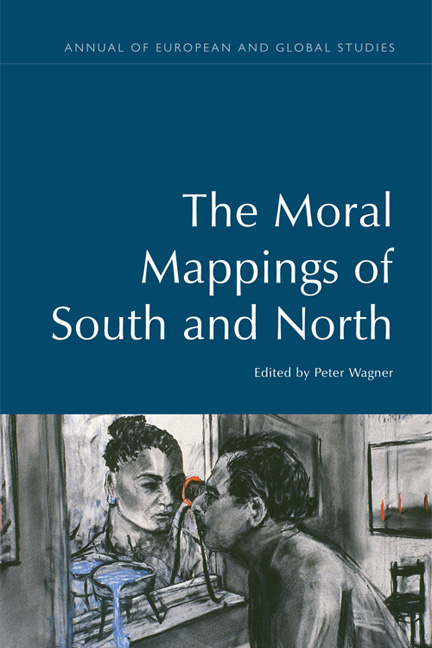Book contents
- Frontmatter
- Contents
- List of Figures
- Notes on the Contributors
- Acknowledgements
- 1 Finding One's Way in Global Social Space
- 2 Does the World Have a Spatio-political Form? Preliminaries
- 3 The BRICS Countries: Time and Space in Moral Narratives of Development
- 4 Russia between East, West and North: Comments on the History of Moral Mapping
- 5 Digging for Class: Thoughts on the Writing of a Global History of Social Distinction
- 6 North–South and the Question of Recognition: A Constellation Saturated with Tensions
- 7 On Spaces and Experiences: Modern Displacements, Interpretations and Universal Claims
- 8 The South as Exile
- Index
4 - Russia between East, West and North: Comments on the History of Moral Mapping
- Frontmatter
- Contents
- List of Figures
- Notes on the Contributors
- Acknowledgements
- 1 Finding One's Way in Global Social Space
- 2 Does the World Have a Spatio-political Form? Preliminaries
- 3 The BRICS Countries: Time and Space in Moral Narratives of Development
- 4 Russia between East, West and North: Comments on the History of Moral Mapping
- 5 Digging for Class: Thoughts on the Writing of a Global History of Social Distinction
- 6 North–South and the Question of Recognition: A Constellation Saturated with Tensions
- 7 On Spaces and Experiences: Modern Displacements, Interpretations and Universal Claims
- 8 The South as Exile
- Index
Summary
Introduction
THE IDEAS of Global South and Global North today seem to have substituted the previous geopolitical notion of an East–West divide as well as the concepts of the First, Second and Third Worlds. It is probably too obvious that this new divide is as biased and as loaded with ideological constructs and unavoidable contradictions as both previous ones. If we pay closer attention to the details, we find the difficulties, which blur the picture. How, for example, did Australia turn out to be in the Global North or Russia, the former leader of the ‘Eastern’ or ‘Second’ World, drift towards the Global South together with its polar regions and Arctic ambitions? It is not really clear how one can unite culturally, geographically, economically and politically different countries into a single unit as wide as a Global North or Global South. If North is neatly defined as European and North American societies (with the possible inclusion of Australia and New Zealand), one can only wonder whether we do not face here the good old Eurocentric world-outlook in just slightly changed clothes. This really becomes obvious when a relatively homogenous ‘North’ is opposed to a ‘South’ containing countries as different as India, Brazil, China, Russia and South Africa. Political will and overlapping interests can probably bring these countries closer within the frameworks of the BRICS countries club; but they cannot change the background of very different histories, the background from the depths of which they ask and answer questions concerning their being in the modern world.
The interesting question, thus, is not why this or that country is included in (or excluded from) the putative or real Global South, but how a particular culture positions itself in a world understood in terms of various geographical, geopolitical and geocultural divides. Essentially the same question is about the ways in which a particular culture maps the globe. Of course, this mapping or positioning is a historical phenomenon and does change with the passing of time. Like large tectonic plates, cultures can also drift to the West or East, float to the South or North and cause violent eruptions when they collide. Thus, countries, which several decades ago were defined as Eastern, now seem to belong to the West or North.
- Type
- Chapter
- Information
- The Moral Mappings of South and North , pp. 72 - 106Publisher: Edinburgh University PressPrint publication year: 2017



